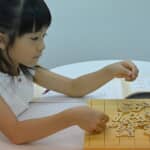Shogi 7 December 2017
Shogi Rules – How to Play Shogi – : Step 3-3 A Value of Each Piece
A professional Shogi player invites you to the world of Shogi along with traditional Japanese culture. In this series, there are three steps and each step has around 10 lessons. Even though you don’t know about Shogi, through these three steps you will get knowledge to enjoy it.
Step 3-3: A Value of Each Piece
In this lesson, you are going to learn a value of each piece. Shogi has eight kinds of pieces and they are ranked according to the importance level that each piece possess. The difference in piece values could be equivalent to that of piece strengths.

Let’s look at levels of piece values in the above figure, starting with Gyoku or Ou (King).
If you lose Gyoku or Ou (King), you will lose a game. What makes Gyoku or Ou (King) to be placed at the top is not so much its strength as its importance. Yes, Gyoku or Ou (King) is placed on top of all pieces.
The piece which is valued secondary is Hisha (Rook). It moves a lot at a time and becomes stronger after getting promoted. You might want to promote it early, and use it carefully and aggressively as much as possible.
Kaku (Bishop) is ranked a little bit lowers than Hisha (Rook) and the thirdly valued piece. Both Hisha (Rook) and Kaku (Bishop) are named “major pieces” which are bigger in size than other pieces. Their big sizes convey their strengths, don’t they? Both pieces can move a lot and are ranked in high levels.
Now, let’s move on values of minor pieces whose sizes a bit smaller. It comes to minor pieces, we should first talk about Kin (Gold). As the fourth piece, Kin (Gold) is good at defense, being close by Gyoku or Ou (King) to protect them. The fifth one is Gin (Silver). Kin (Gold) and Gin (Silver) are similar to each other and a thing different is that Kin (Gold) can move one square more than Gin (Silver). That gives Kin (Gold) higher value than Gin (Silver).
Kei (Knight) comes as the sixth one and Kyo (Lance) as the seventh. The last one is Fu (Pawn). Fu (Pawn) is regarded the lowest valued piece among all eight kinds. Even though it has the lowest value, the number of pieces is the largest. Once you get the hang of using Fu (Pawn) effectively, you will be able to become a good player. There is a Shogi proverb, “Ichifu senkin” which means one piece of Fu (Pawn) is a worth a thousand Kin (Gold). As it tells us, in some situations, Fu (Pawn) does more valuable works than Kin (Gold).
As your basic knowledge, it’s important to know the differences in values shown in the above figure. With sound understandings about piece values, you may get the upper hand at exchanging pieces and have the best choice when you are attacking two pieces at the same time (you will learn these topics later).
After Today’s Lesson
The aim of today’s lesson is to learn piece values. “Oh, it’s the same order as the one which we follow when we set pieces, My girls said and remembered them easily. They always set pieces following Ohashi style and its order can be applied for that of piece values, except for Hisha (Rook) and Kaku (Bishop).
“What Hisha (Rook) will become when it gets a promotion?”, I asked. “Ryu (Promoted Rook)”, children answered with vigor. The most powerful piece gains the popularity the most. The teacher gave children meaningful words, “Kin (Gold)” works as a bodyguard for Gyoku or Ou (King)”, “One Gin (Silver) works as defence and the other works as offence”. Her words teach us each piece has its own role.
She also said, “There are several techniques to use Fu (Pawn). When you have a good understanding of using Fu (Pawn), your Shogi skills will be developed. My children amazed to know how useful Fu (Pawn) are and how greatly it can be strengthen with its promotion, saying “Fu (Pawn) becomes Kin (Gold) after getting its promotion, which means it will be upgraded to the fourth piece, advancing four ranks”.
Next Step
Did you understand all of today’s lesson? Is everything alright with you? In the next step, you will learn about effective piece capturing.

